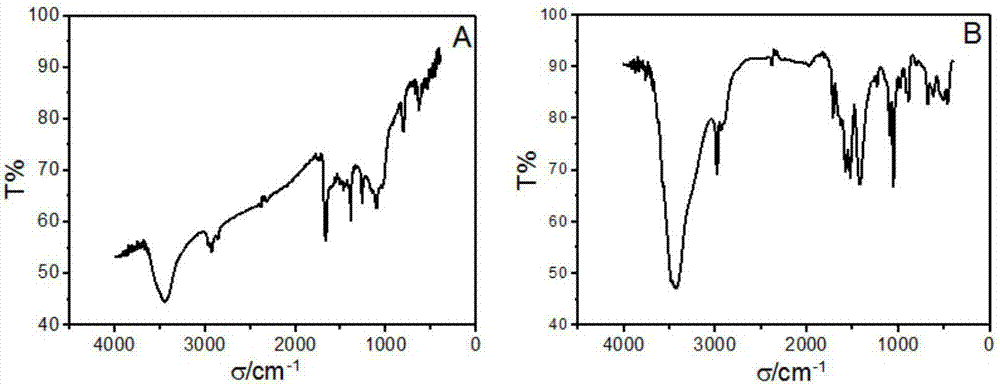Electrochemical sensor for detecting triclosan, preparation method and application thereof
A triclosan and electrochemical technology, applied in the field of electrochemical detection, can solve the problems of catalytic performance, detection limit and detection range, etc., and achieve excellent electrocatalytic activity, low cost, and good stability
- Summary
- Abstract
- Description
- Claims
- Application Information
AI Technical Summary
Problems solved by technology
Method used
Image
Examples
Embodiment 1
[0039] Example 1 Preparation of a chemically modified electrode for detecting triclosan
[0040] (1) Add 20mg of nitrogen-doped graphene to 20mL of water, and disperse evenly by ultrasonication for 15min;
[0041] (2) Add 0.1mL 0.1mol / L CuCl to the above dispersion 2 After stirring evenly, add 0.0878g of sodium lauryl sulfate and fully dissolve it in a water bath at 35°C under the action of magnetic stirring;
[0042] (3) Then add 0.18mL of 1.0mol / L NaOH solution, then add 0.5mL of 0.1mol / L glucose, heat to a slight boil at 5mim under magnetic stirring, cool to room temperature, and then centrifuge, wash twice with water and then centrifuge Get Cu 2 O / NRGO;
[0043] (4) Dissolve the prepared Cu with 5mL water 2 O / NRGO is ultrasonically dispersed in a beaker;
[0044] (5) Weigh 5mg PbCl 2 , dissolved in 2 mL of water and added dropwise to Cu 2 Stir evenly in the O / NRGO dispersion;
[0045] (6) Another 0.5 g of ascorbic acid was taken, dissolved in 2 mL of water, and add...
Embodiment 2
[0048] Example 2 An electrochemical sensor for the quantitative detection of triclosan
[0049] The Pd-Cu prepared by embodiment 1 2 The O / NRGO modified electrode was used as the working electrode, the Ag-AgCl was used as the reference electrode, and the platinum electrode was used as the auxiliary electrode to assemble a three-electrode test system, and connected to the electrochemical workstation to obtain an electrochemical sensor for the quantitative detection of triclosan.
Embodiment 3
[0050] Example 3 Electrical Performance Test of Chemically Modified Electrodes and Electrochemical Sensors Used for Triclosan Quantitative Detection
[0051] (1) Comparison of electron transfer performance of different electrodes
[0052] In the three-electrode test system prepared as in Example 2, the glassy carbon electrode (a), Cu 2 O-NRGO modified electrode (b) and Pd-Cu according to the present invention 2 O / NRGO modified electrode (c) at 5×10 -3 mol / L K 3 [Fe(CN) 6 ] Mixed with 0.10mol / L KCl bottom solution for cyclic voltammetry test, the test conditions are: potential range -0.2~0.6V, scanning speed 0.05V / s, the test results are as follows Figure 4 . From Figure 4 Visible K 3 [Fe(CN) 6 ] at the glassy carbon electrode (a), Cu 2 O-NRGO modified electrode (b) and Pd-Cu according to the present invention 2 The oxidation peak currents on the O / NRGO modified electrode (c) were 2.2 μA, 14.5 μA and 47.6 μA, respectively. 2 The O / NRGO modified electrode has the la...
PUM
| Property | Measurement | Unit |
|---|---|---|
| particle diameter | aaaaa | aaaaa |
| particle diameter | aaaaa | aaaaa |
| current | aaaaa | aaaaa |
Abstract
Description
Claims
Application Information
 Login to View More
Login to View More - R&D
- Intellectual Property
- Life Sciences
- Materials
- Tech Scout
- Unparalleled Data Quality
- Higher Quality Content
- 60% Fewer Hallucinations
Browse by: Latest US Patents, China's latest patents, Technical Efficacy Thesaurus, Application Domain, Technology Topic, Popular Technical Reports.
© 2025 PatSnap. All rights reserved.Legal|Privacy policy|Modern Slavery Act Transparency Statement|Sitemap|About US| Contact US: help@patsnap.com



